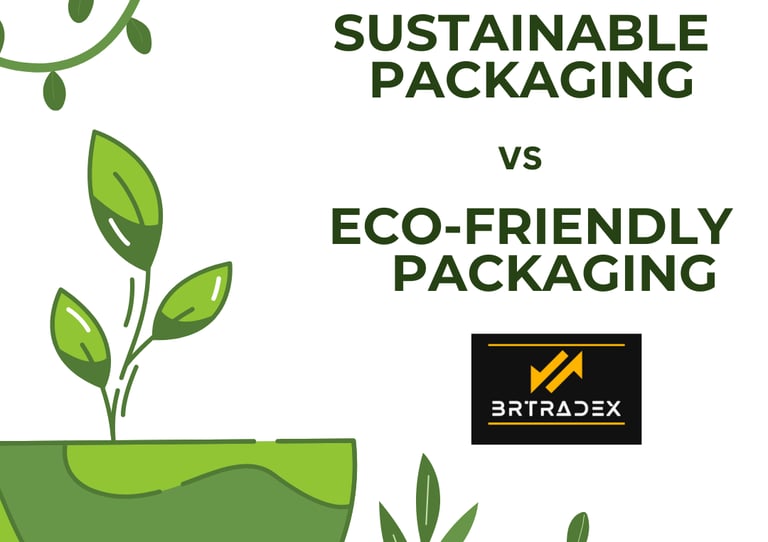Understanding Sustainable Packaging: Beyond Eco-Friendly Labels
🌿 Sustainable Packaging vs. Eco-Friendly: Know the Difference! Not all “green” packaging is truly sustainable. Learn how to choose materials that protect your products and the planet, reduce waste, and minimize environmental impact from production to disposal. ♻️ 📦 Pack smarter, safer, and greener with BR Tradex.
2 min read
Understanding Sustainable Packaging: Beyond Eco-Friendly Labels
In a world increasingly aware of environmental challenges, businesses and consumers alike are turning to sustainable packaging. But what does it really mean? Is it the same as “eco-friendly”? How can you tell what truly helps the planet—and what is just marketing hype? Let’s dive deep.
What is Sustainable Packaging?
Sustainable packaging is a holistic approach to designing, sourcing, and using packaging that minimizes environmental impact throughout its entire lifecycle—from raw material extraction to production, transportation, usage, and disposal. It’s not just about being recyclable or compostable; it’s about responsible choices that consider energy use, emissions, waste, and social responsibility.
A sustainable packaging system aims to:
✔ Reduce the carbon footprint of packaging materials and processes.
✔ Minimize waste generation and encourage reuse.
✔ Use materials from renewable or responsibly managed sources.
✔ Ensure packaging is safe for the environment and human health.
✔ Support ethical sourcing and fair labor practices.
Eco-Friendly vs. Sustainable Packaging: What’s the Difference?
Many people use eco-friendly and sustainable interchangeably—but they’re not the same.
Eco-Friendly Packaging:
Focuses on reducing immediate harm to the environment.
Examples include biodegradable plastics, recyclable paper, and plant-based wraps.
Usually judged on end-of-life impact—whether it can be recycled, composted, or reduces pollution.
Sustainable Packaging:
Takes a broader view, considering the entire lifecycle of the material.
Includes production methods, energy used in manufacturing, transportation efficiency, and social impact.
Often overlaps with eco-friendly materials but also emphasizes long-term resource management and systemic impact.
In short: All sustainable packaging is eco-friendly, but not all eco-friendly packaging is sustainable.
Examples of Sustainable Packaging
Honeycomb Paper Rolls & Sleeves
Made from recycled paper and are 100% recyclable.
Lightweight, durable, and reduce the need for plastic bubble wrap.
Corrugated Boxes & Paper Boards
Recyclable, biodegradable, and strong enough to replace plastic crates.
Paper Tubes & Angles
Used for winding textiles, films, or for protective packaging.
Renewable and reusable, reducing single-use plastics.
Eco-Friendly Mailer Envelopes
For small e-commerce shipments.
Biodegradable, reducing packaging waste significantly.
What Is NOT Sustainable or Eco-Friendly Packaging?
Unfortunately, not all “green-looking” packaging is actually beneficial. Common non-sustainable packaging includes:
Single-use plastics: Even if labeled recyclable, many plastics end up in landfills or oceans due to poor recycling infrastructure.
Mixed-material packaging: Laminates combining plastic, foil, and paper are difficult to recycle.
Excessive packaging: Over-packaging products adds unnecessary waste and carbon footprint.
Materials sourced unsustainably: Paper from non-certified forests or plastics from fossil fuels without recycling plans.
Essentially, if a packaging material cannot be responsibly produced, reused, recycled, or composted, it’s not sustainable, even if marketed as “green.”
Why Choose Sustainable Packaging?
✅ Environmental Responsibility – Reduce your carbon footprint and waste.
✅ Consumer Appeal – Modern consumers increasingly prefer brands that care about the planet.
✅ Regulatory Compliance – Many countries are introducing laws limiting plastic and promoting sustainable packaging.
✅ Cost Efficiency – Lightweight, recyclable, or reusable materials often reduce shipping and disposal costs.
Sustainable packaging is not just a trend—it’s a long-term commitment to the planet and future generations.
Closing Thoughts
Switching to sustainable packaging is about making mindful choices at every step—from material selection to design, production, and disposal. By understanding the difference between eco-friendly and truly sustainable solutions, businesses can reduce their environmental impact without compromising product protection or customer experience.
At BR Tradex, we specialize in eco-conscious, high-strength packaging solutions that are recyclable, reusable, and plastic-free, helping you pack smarter, safer, and greener.
📦 Explore our range of honeycomb paper rolls, sleeves, boxes, and more, and take the first step toward truly sustainable packaging.



Connect
Follow us for updates:
Follow
Subscribe
Mail : info@brtradex.com
Call +91-9560253636
©BRTRADEX 2025. All rights reserved.
rEFUND pOLICY
